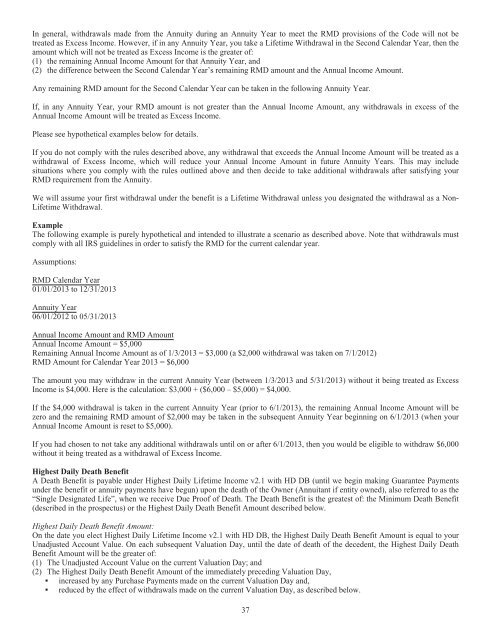Prudential Premier Retirement Variable Annuities
Prudential Premier Retirement Variable Annuities
Prudential Premier Retirement Variable Annuities
Create successful ePaper yourself
Turn your PDF publications into a flip-book with our unique Google optimized e-Paper software.
In general, withdrawals made from the Annuity during an Annuity Year to meet the RMD provisions of the Code will not be<br />
treated as Excess Income. However, if in any Annuity Year, you take a Lifetime Withdrawal in the Second Calendar Year, then the<br />
amount which will not be treated as Excess Income is the greater of:<br />
(1) the remaining Annual Income Amount for that Annuity Year, and<br />
(2) the difference between the Second Calendar Year’s remaining RMD amount and the Annual Income Amount.<br />
Any remaining RMD amount for the Second Calendar Year can be taken in the following Annuity Year.<br />
If, in any Annuity Year, your RMD amount is not greater than the Annual Income Amount, any withdrawals in excess of the<br />
Annual Income Amount will be treated as Excess Income.<br />
Please see hypothetical examples below for details.<br />
If you do not comply with the rules described above, any withdrawal that exceeds the Annual Income Amount will be treated as a<br />
withdrawal of Excess Income, which will reduce your Annual Income Amount in future Annuity Years. This may include<br />
situations where you comply with the rules outlined above and then decide to take additional withdrawals after satisfying your<br />
RMD requirement from the Annuity.<br />
We will assume your first withdrawal under the benefit is a Lifetime Withdrawal unless you designated the withdrawal as a Non-<br />
Lifetime Withdrawal.<br />
Example<br />
The following example is purely hypothetical and intended to illustrate a scenario as described above. Note that withdrawals must<br />
comply with all IRS guidelines in order to satisfy the RMD for the current calendar year.<br />
Assumptions:<br />
RMD Calendar Year<br />
01/01/2013 to 12/31/2013<br />
Annuity Year<br />
06/01/2012 to 05/31/2013<br />
Annual Income Amount and RMD Amount<br />
Annual Income Amount = $5,000<br />
Remaining Annual Income Amount as of 1/3/2013 = $3,000 (a $2,000 withdrawal was taken on 7/1/2012)<br />
RMD Amount for Calendar Year 2013 = $6,000<br />
The amount you may withdraw in the current Annuity Year (between 1/3/2013 and 5/31/2013) without it being treated as Excess<br />
Income is $4,000. Here is the calculation: $3,000 + ($6,000 – $5,000) = $4,000.<br />
If the $4,000 withdrawal is taken in the current Annuity Year (prior to 6/1/2013), the remaining Annual Income Amount will be<br />
zero and the remaining RMD amount of $2,000 may be taken in the subsequent Annuity Year beginning on 6/1/2013 (when your<br />
Annual Income Amount is reset to $5,000).<br />
If you had chosen to not take any additional withdrawals until on or after 6/1/2013, then you would be eligible to withdraw $6,000<br />
without it being treated as a withdrawal of Excess Income.<br />
Highest Daily Death Benefit<br />
A Death Benefit is payable under Highest Daily Lifetime Income v2.1 with HD DB (until we begin making Guarantee Payments<br />
under the benefit or annuity payments have begun) upon the death of the Owner (Annuitant if entity owned), also referred to as the<br />
“Single Designated Life”, when we receive Due Proof of Death. The Death Benefit is the greatest of: the Minimum Death Benefit<br />
(described in the prospectus) or the Highest Daily Death Benefit Amount described below.<br />
Highest Daily Death Benefit Amount:<br />
On the date you elect Highest Daily Lifetime Income v2.1 with HD DB, the Highest Daily Death Benefit Amount is equal to your<br />
Unadjusted Account Value. On each subsequent Valuation Day, until the date of death of the decedent, the Highest Daily Death<br />
Benefit Amount will be the greater of:<br />
(1) The Unadjusted Account Value on the current Valuation Day; and<br />
(2) The Highest Daily Death Benefit Amount of the immediately preceding Valuation Day,<br />
▪ increased by any Purchase Payments made on the current Valuation Day and,<br />
▪ reduced by the effect of withdrawals made on the current Valuation Day, as described below.<br />
37

















